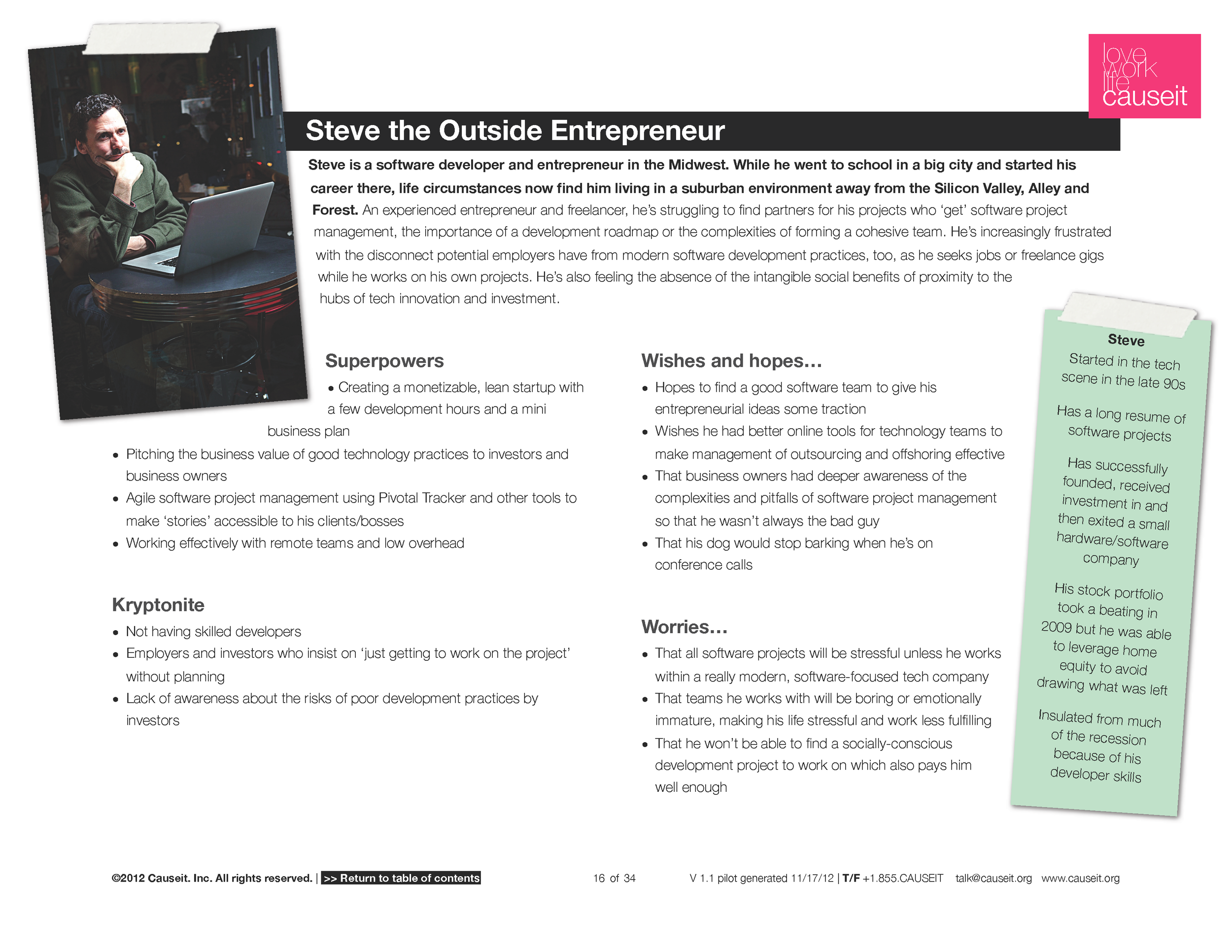Opening the Door for Innovation
In this pilot ethnography and concept piece, we asked questions about where untapped innovation potential is. Based on real-life interviews with people representing these experience models, we found that—not surprisingly—many barriers to innovation still have to do with access to the confluence of social, financial and human capital—connections, cash and skill.
Download the hyperlinked PDF in print/retina (7 mb) or screen (3.1 mb) resolution here, or see the slideshow (without hyperlinks) at the bottom of the page if you do not have easy access to a PDF viewer.
Project Excerpt: How Good Ideas Become Real Innovations
by MJ Petroni, Principal, Causeit, Inc,
Steven Johnson's deep dive into the patterns of innovators, Where Good Ideas Come From, explores the environmental factors supportive of innovation and how good ideas come to be. Johnson’s work centers on where innovations are conceived, but spends less time on the factors affecting their birth. While reading the book, it occurred to me to ask, “If so many brilliant ideas are emerging, why aren’t more being put into action?”
The animated intro to Johnson’s book provides a quick dive into ideas—and begs the question of how to make the best ones real. [youtu.be/NugRZGDbPFU]
Most of the discussions around innovation on TechCrunch or VC blogs are talking about software/hardware companies in the fertile innovation zones of the world: California's Silicon Valley, NYC's Silicon Alley, and the Pacific Northwest's Silicon Forest. There is innovation happening outside the tech world—and tech innovation outside these hotspots—but, by comparison, it’s rarely discussed in popular media. We set out to understand some of what's happening in innovation outside of the buzz that’s informing predominant policy discussions.
Innovation in the States
According to a recent Brookings Institute report, US innovation outside the tech sector is in trouble. The Institute asserts that innovation is not increasing wages for average Americans at the rate that it has in the past, and that few college students are receiving degrees directly relevant to the most talked-about types of innovation (~36% of STEM Bachelor degrees, to be more specific). So how can we bring innovation’s economic benefits to bear on the much discussed jobs war by making innovation accessible to small- and mid-sized businesses?
If our goal is to create good jobs and broad socioeconomic improvement, we need to borrow lessons from the tech sector about how to collaborate on, fund and protect emerging innovations in other fields.
The hidden players in innovation—and why they’re on the bench
The project originally started with the idea of playing cards, with innovation players (think persona models) and their strengths and weaknesses in the innovation game. We began exploring the ways innovation occurs beyond product development, and then sketched hypothetical players in those realms of innovation—giving the models names like Steve the Outside Entrepreneur (a tech startup veteran remote from the culture of the “Valleys”), Janette the Makerpreneuer (a tangible-goods craftsperson), and Gabriela the Mom (working outside the home in an economically-barren environment).
In this pilot ethnography and concept piece, we asked questions about where the untapped potential is and what opportunities exist. Based on real-life interviews with people representing these experience models, we found that—not surprisingly—many barriers to innovation still have to do with access to the confluence of social, financial and human capital—connections, cash and skill.
What are the right questions?
After you’ve seen the first draft of the research and concept piece, we’d love to hear feedback on what you see enabling innovation, the blindspots of innovation discussion, and what you’d like to see researched next.
MJ Petroni
Principal, Causeit, Inc.
Open or download the PDFs of the project at the top of the page, or use the slideshow below to preview the report (internal links do not work in the preview below).





































